
Search Wild Foods Home Garden & Nature's Restaurant Websites:
Blueberries

(NOTE: If you are not interested in growing Blueberries, but just finding them in the wild, try going to the Nature's Restaurant Online site for Blueberries.)
Blueberries are in the Vaccinium genus, and there are numerous types.
There are two basic groups of Blueberries, the “Highbush” which are the most common commercially grown types, and the “Lowbush” type which are sold as “Wild”. When you buy ones at the store that are called “Wild Blueberries”, that doesn't mean picked by hand from non-cultivated plants. It is a reference that the Blueberries came from a “Lowbush” variety.
There are four ways to get the plants. The most obvious is buy them from a nursery. The advantage to this is hopefully they sell the varieties that do best where you live, and are disease resistant. The downside is the cost of course. If you live in an area that has them growing in the wild, you can transplant small ones. The third way is by seed. The cost is low, but it will take at least two years before you see a Blueberry for picking. The fourth way is to propagate from cuttings.
Is the growing of this plant compatible with Natural farming, Ecoagriculture or Eco friendly agriculture, Ecological farming, Sustainable agriculture, Agroforestry or Agro-sylviculture and Permaculture: These are good to include in Natural farming no-till gardens. Once established, you do not need to disturb the soil.
Transplanting: Do this in the dormant season of early spring or fall, but not when there is a chance of a hard frost. This way is free, the plants are adapted to your area and area's soils, and if done right, you could have some Blueberries by next year. But, that said, I'd strongly advise to pull off all the flowers the season after transplanting to let the Blueberry bush put its energy into developing the root system. The bushes have a shallow root system, so 30 cm (1 foot) deep should do it. The roots are lateral spreading, so get as wide an area as you can without having the root ball fall apart. Take and plant in the prepared site. If you transplant in the spring, mulch and keep the ground wet for the first season, by watering when there isn't rain. If you transplant in the fall, water well after transplanting and put a deep mulch around it.
Seeds: If you do decide to grow from seed, you have two options. Grow them from the seeds in the Blueberries you collect around you, or buy seeds in packages from seed companies. Seeds in packages should already have been put through the required freezing period to break them from dormancy. If starting from seeds you got from Blueberries you collected, just put a few choice ones in a baggie in the freezer and leave for at least three months.
Next, you will need to get the flesh off the seeds. I suggest putting them in a large container, adding room temp water, leave them for a few minutes until they thaw and rub them around with your hands. Carefully separate the flesh and water from the seeds by pouring off the water and repeat until you get seeds. You can use a blender for this as well.
Put the seeds in a growing flat with about 7.5 cm (3 inches) of good quality fine peat moss (make sure it is damp before you put the seeds on it) and spread the seeds over the surface and sprinkle a fine, thin layer of more damp peat moss over it. Cover with the plastic lid that comes with the growing flat. They shouldn't be in much light until they sprout, and keep the peat moss evenly damp by misting with water - do not make it soaking wet. It will take a while, 3-5 weeks before they sprout. After they sprout, put in diffuse sun light and keep moist by misting. Once they have grown to the point where they are touching the lid of the growing flat, transplant to pots with soil. Either use bagged soil that your garden supply store recommends, or just use 1/3 potting soil, 1/3 sand and 1/3 peat moss. The little plants are very weak and tender. What I have found is the best way to transplant them without tearing the roots is to cut the surrounding soil with a knife and use a tablespoon to act as a scoop to get them out and in the pots.
Keep damp but not wet in a sunny location in the pots until the danger of frost is gone and transplant to the garden. They will still be tender, so you may want to cover them with little chicken wire covers or something similar that lets the air and light in, but keeps squirrels and the like out.
Cuttings: This can work, but you might have trouble getting them to root unless you are meticulous with getting it right, and making sure they do not dry out at all - and that includes keeping the air humid around them. Nurseries propagate this way to carry on a line of bushes that have the characteristics they want.
Depending where you live (north or south of Eastern North America), the timing could be a little different, but sometime in later May to Early June when bushes you want to clone have shoots that are about 25-30 cm (10-12 inches), take a container of water and a sharp pair of scissors or a razor sharp, clean blade and take the cuttings of 25-30 cm (10-12 inches). You want them slightly woody, but not older barked branches. You also don't want them when they are too green - you can tell because really immature ones will snap when bent. Do this early as you can in the morning. When each one is cut, put the cut end in the water right away.
When you get back to your work area, pull off half to two thirds of the leaves from the lower part of the cuttings and push into very damp, aged, fine Pine bark - sometimes called "milled pine bark" at nurseries, and is sold in bags. If you can't get this, use 1/3 sand, 1/3 peat moss, 1/3 potting soil and make sure it is full wetted for at least a couple of hours before you put in the cuttings. You can use a hardwood rooting hormone, but they might not need it. Push them into the soil medium about half to two thirds of the way. You have to keep them moist and misted all the time. A small room with a cool mist humidifier would be great, or you can put clear bags over them with a pencil sized hole to let it breath - keep the bag from touching the cuttings. They need to be kept where there is bright light, but not direct, hot sun. In about 1 1/2 to 2 months, if they take you should see them starting to grow. At that point, carefully transplant outside and keep the soil damp for the full season, and protect from full sun during mid day or when really hot and dry.
Soil & Site: To successfully grow Blueberries, there are a few points you have to check off on your list first. They need lots of light. Most of the day, the sun should shine on them. The soil they are to be grown in needs to be able to drain well, and be quite loamy. It needs to be acidic - find the right range for the ones you plant. And finally, the soil needs to be rich in organic matter. If the soil is heavy and not porous (holds water on the surface), till into the soil course sand and peat moss.
If you have the sunny spot, you can always create a raised bed to improve drainage. If your soil is not acidic there are different ways of making it acidic. You can dig in any kind of conifer tree needles or sawdust, ad Ammonium Sulphate fertilizer or Ground Sulphur fertilizer. Don't overdo it all at once. You can mix in the sawdust or needles, plant the Blueberry plants, and add either one of the mentioned fertilizers each year. By the way, it is a very good idea to have a soil pH test kit, or have the soil tested, not just for Blueberries but other plants as well. By keeping the pH right for each plant, you get the most for the area you plant, plus the plants are more resistant to problems. Just as a starting point, add 1/2 Kg (1 pound) of sulphur per 10 square meters (100 square feet) of area to lower the pH by 1 point. Till the sulphur into the soil at least 15 cm (6 inches) deep.
Planting: Whether you buy or transplant them from the woods, dig a hole about twice as big as the root ball on each Blueberry shrub, mix the soil from the hole with peat moss and either bark mulch or conifer needles and some composted manure. Then plant the Blueberry so that where the soil level was on the plant when you got it comes to the same point. Make sure you water them well to get established and deep water them if they start to dry out badly from then on. When planted, prune out 20-25% of the branches. Always take out the darker, older branches when pruning.
Maintenance: In the first year after planting, pull off all flowers so the bushes cannot produce fruit. Hard to do, as you want to get the fruit, but by doing this the bush will get bigger and stronger faster, and will reward you will better harvests in the second season and onwards. Each spring, put some bark mulch and peat moss and some composted manure over the soil where they grow, but not deeply, just a shallow covering. If you live where the soil is not naturally acidic, when you fertilize, use an acidifying fertilizer. If you live where the soil in the area is naturally acidic, either just use the composted manure in the spring, or put a little of 10-5-5 garden fertilizer on them lightly. If the leaves start turning yellow, try adding a little nitrogen fertilizer to them and see if it helps. If not, you may need to have a more thorough soil test done to find the problem.
For pruning on the Highbush types: You can do this every year or every two years in very early spring or late winter depending on the climate zone. If you do it every year, only do a light pruning. Don't start pruning until the bushes have been growing where you put them for four seasons. The basic idea is simple, remove any sick, dead, and overcrowded branches first. Take out ones that are six to seven years old and ones that hang to the ground. When you are done, the bush should have a general V shape, be able to let air pass near the ground, and not have crossed and tangled branches. Take a look at pictures here so you know what you are aiming for when done.
For pruning the Lowbush types: Every 2-4 years cut off all the branches right to the ground. Because the next season you will not get fruit, rotate in sections when you do this. So, lets say you decide to do it every three years, then divide your Lowbush Blueberry patch into three areas, and prune back one section each year. That way, you will always have two sections producing fruit.
Container Growing: They are not hard to grown in pots if you get the correct variety - it will need to be one of the "Lowbush" types. Just use an acidic soil mix (ask where you buy bags of soil) and use an acidifying fertilizer. When you buy them or seeds, ask for a variety that will do well for container growing. Never put lime on soil Blueberries are grown in. You must make sure the soil does not dry out fully, as this could kill them.
Harvesting: They will be ready in late July to mid August. When getting closer to harvest time, you may have to put a mesh over your Blueberry bushes to keep the birds away. They are available at garden stores, nurseries and even some country hardware stores. When ripe, they should come off the bush with very little effort. It's a slow process by hand, and there are hand rakes available if you plant a lot. Only pick the ones that are blue and round. If they are small and hard or cracked, leave them. If you are using a rake and can't help take the others, you will have to pick them out later.
Using: Blueberries are great to eat raw, cooked or in baked foods. They freeze well.
Web Resources:
Recipe search on the web here (Google search) and here (Bing search).
Description:
I have included descriptions of the most common varieties you will find in the wild in Eastern North America. There are many cultivars that can be purchased from nurseries. Most, if not all are based on one or more of the following native shrubs.
Northern Highbush Blueberry (Vaccinium corymbosum). Has other common names such as: Blue Huckleberry, Swamp Huckleberry, Swamp Blueberry.
- USDA Plant Hardiness Zone: 3-7 (More information on hardiness zones).
- Soil pH: 4.0-5.2
- Plant Size: 2-4 meters (6 to 12 feet) tall. Often forms dense areas.
- Duration: Deciduous Shrub to small tree that can live and produce fruit for many years.
- Leaf Shape: Elliptical
- Leaf Phyllotaxis (Arrangement) on branch: Alternate
- Leaf Size: Up to 6 cm (2 1/2 inches) long
- Leaf Margin: Entire (smooth edged) to very finely Serrated (saw toothed edge)
- Leaf Notes: Dark glossy green, In autumn, vibrant orange, red, purple and yellow. One bush can have a mixture of fall leaf colors. Often, when green, the leaf is paler below than on the top side.
- Flowers: Lantern or bell shaped, white to light pink, 8 mm (1/3 inch) long
- Fruit: Ripe mid to late summer, 8 mm (1/3 inch) diameter, dark blue
- Bark: On older trunks, grey-brown to reddish-brown, shredded. Twigs are thin, green and red and have a zig-zag growth pattern.
- Habitat: Likes quite acidic soil, so not to be found associated with limestone rocks. Can be in dry to wet areas, but seems more common on damp sites near wetlands. Be careful, as Poison Ivy, Western Poison Ivy likes the same damp areas as this shrub. Can withstand full sun, but does best in open, slightly shaded areas that are damp.
Web Resources:
- Pictures on the web here (Google images) and here (Bing images).
- Interactive USDA distribution map and plant profile here.
- The Biota of North America Program (BONAP) distribution map here. BONAP map color key here.
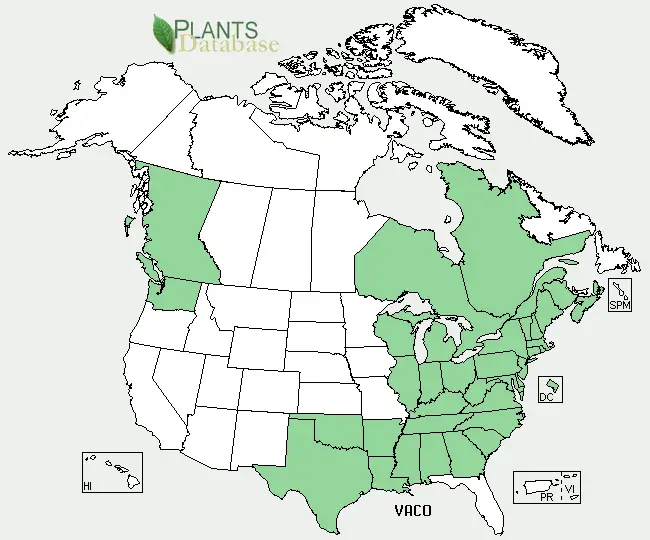
Northern Highbush Blueberry (Vaccinium corymbosum) range. Distribution map courtesy of U. S. Department of Agriculture (USDA Natural Resources Service) and used in accordance with their policies.
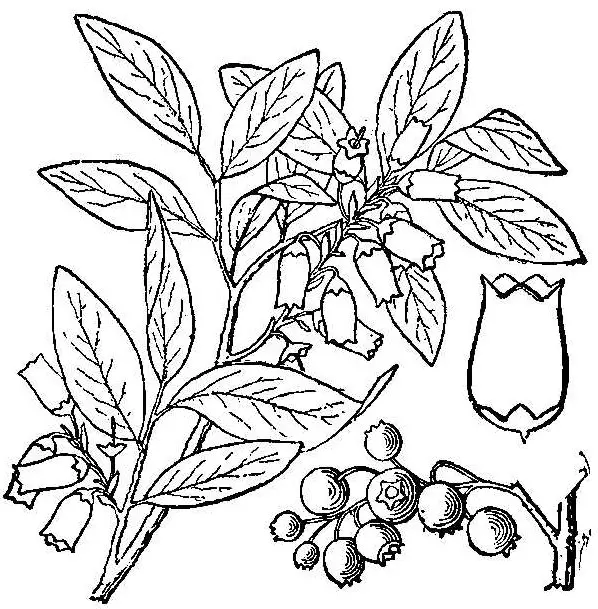
Northern Highbush Blueberry (Vaccinium corymbosum) sketch. (USDA-NRCS PLANTS Database / Britton, N.L., and A. Brown. 1913. An illustrated flora of the northern United States, Canada and the British Possessions. 3 vols. Charles Scribner's Sons, New York. Vol. 2: 700.)
Canadian Blueberry (Vaccinium myrtilloides). Also known as the Common Blueberry, Velvetleaf Blueberry, Sourtop Blueberry, Velvetleaf Huckleberry. This is the sweetest tasting of the Blueberries.
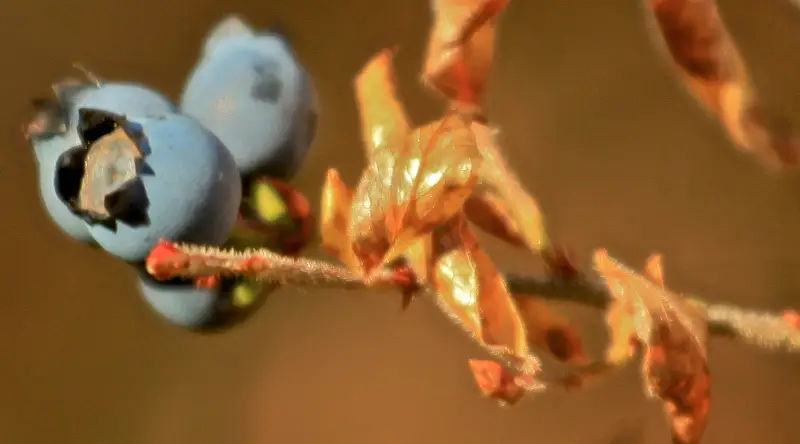
Canadian Blueberries
- USDA Plant Hardiness Zone: 2-7 (More information on hardiness zones).
- Soil pH: 3.0-5.9, ideal: 4.5-5.5
- Plant Size: To 50 cm (20 inches) tall, low and spreading, forms thickets
- Duration: Shrub that can live and produce fruit for many years
- Leaf Shape: Ovate to Elliptic
- Leaf Phyllotaxis (Arrangement) on branch: Alternate
- Leaf Size: 10–40 mm (2/5 to 1 3/5 inches) long, 5–15 mm (1/5 to 3/5 inch) wide
- Leaf Margin: Entire (smooth edged)
- Leaf Notes: Bright green and hairy above, bottom of leaf: lighter green with velvety hairs. Leaves can have red dots or blotches.
- Flowers: White, lantern or bell-shaped, 5 mm long
- Fruit: Smaller than most other Blueberries, bright blue to dark blue, sweet tasting
- Bark: Green to reddish even on new growth. Young stems have dense, stiff hairs that are whitish in color.
- Habitat: From dry to wet, sandy to rocky acidic soils. Full sun to partial shade. A colonizer of cleared lands or lands after a forest fire. It is fire tolerant, and will come back with new growth from roots even if above ground part of shrub is burned
Web Resources:
- Pictures on the web here (Google images) and here (Bing images).
- Interactive USDA distribution map and plant profile here.
- The Biota of North America Program (BONAP) distribution map here. BONAP map color key here.
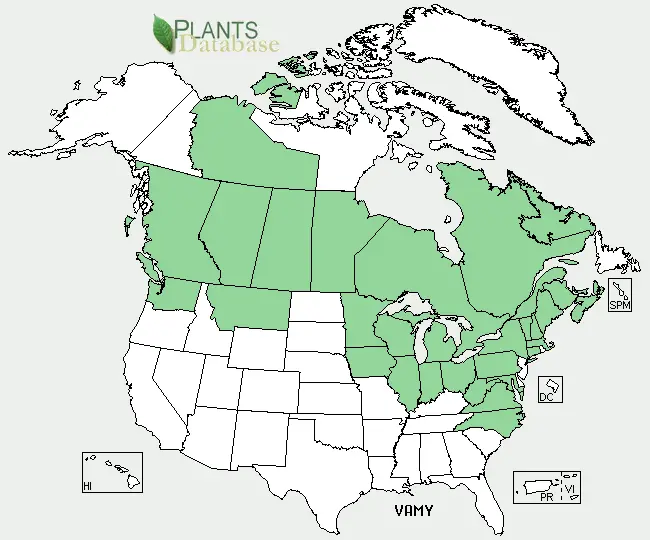
Canadian Blueberry (Vaccinium myrtilloides) range. Distribution map courtesy of U. S. Department of Agriculture (USDA Natural Resources Service) and used in accordance with their policies.
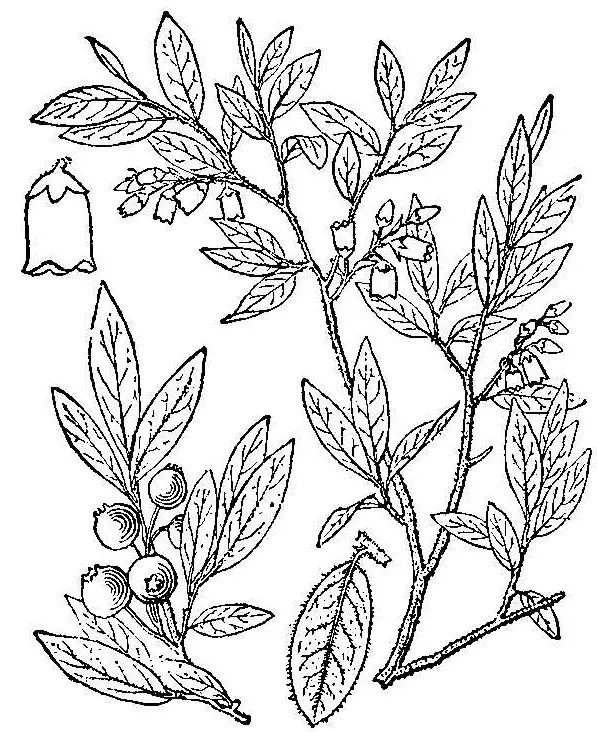
Canadian Blueberry sketch. (USDA-NRCS PLANTS Database / Britton, N.L., and A. Brown. 1913. An illustrated flora of the northern United States, Canada and the British Possessions. 3 vols. Charles Scribner's Sons, New York. Vol. 2: 701.)
Lowbush Blueberry (Vaccinium angustifolium).
- USDA Plant Hardiness Zone: 3-6 (More information on hardiness zones).
- Soil pH: 2.8-6.6, best range: 4.2-5.2
- Plant Size: Shrub, usually 30 cm (12 inches) high, although can be almost double that occasionally. Tends to stay low and spread horizontally.
- Duration: Can live and produce berries for many years
- Leaf Shape: Simple (not compound), Elliptical
- Leaf Phyllotaxis (Arrangement) on branch: Alternate
- Leaf Size: 20-40 mm (3/4 to 1 3/5 inches) long 6-20 mm (1/4 to 3/4 inch) wide
- Leaf Margin: Very finely Serrated (saw toothed edge)
- Leaf Notes: Leaves have very short stems.
- Flowers: 6 mm (1/4 inch) long lantern shaped white or pinkish-white flower that hangs down from its stem.
- Fruit: Small, sweet. Color is dark blue to blue-black
- Bark: Fresh growth twigs are green, older twigs are reddish-brown, bark on mature stems is rough, woody and sometimes coming off in shreds.
- Habitat: Prefers sandy soil that is mildly to very acidic. Common in open woods, but not in deep shade. Takes advantage of fires to colonize openings where woods were burned. Associated with conifer trees.
Web Resources:
- Pictures on the web here (Google images) and here (Bing images).
- Interactive USDA distribution map and plant profile here.
- The Biota of North America Program (BONAP) distribution map here. BONAP map color key here.
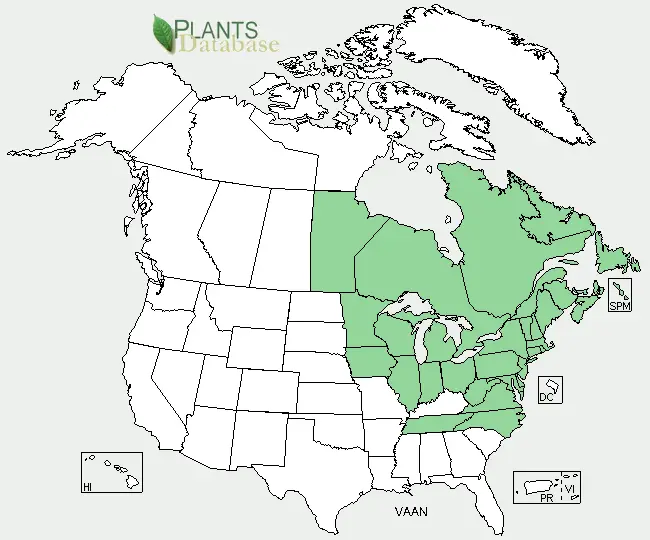
Lowbush Blueberry (Vaccinium angustifolium) range. Distribution map courtesy of U. S. Department of Agriculture (USDA Natural Resources Service) and used in accordance with their policies.
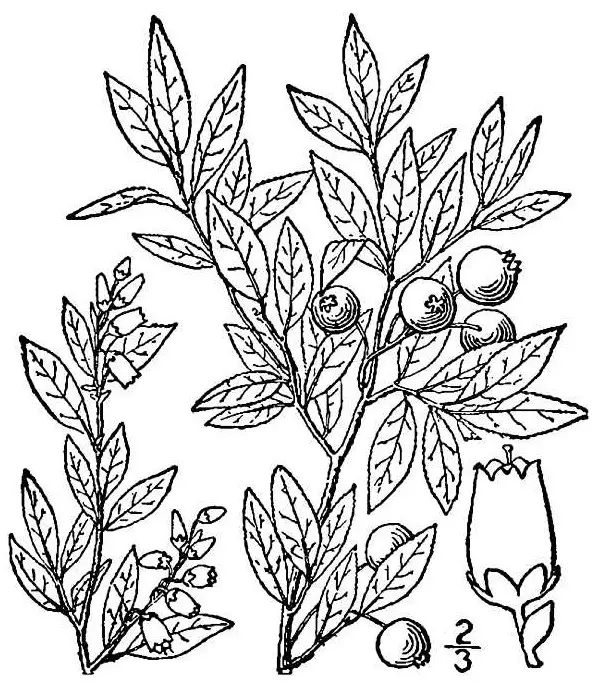
Lowbush Blueberry sketch. (USDA-NRCS PLANTS Database / Britton, N.L., and A. Brown. 1913. An illustrated flora of the northern United States, Canada and the British Possessions. 3 vols. Charles Scribner's Sons, New York. Vol. 2: 701.)
Northern Blueberry (Vaccinium boreale). Also called the Alpine Blueberry.
- USDA Plant Hardiness Zone: No data, but northern, colder areas. (More information on hardiness zones).
- Soil pH: acidic
- Plant Size: Very low - 10 cm (4 inches) or less high
- Duration: Shrub that can live and produce berries for years.
- Leaf Shape: Elliptic.
- Leaf Phyllotaxis (Arrangement) on branch: Alternate
- Leaf Size: leaves 8–21 mm (1/3 to 4/5 inch) long and 2-6 mm (1/10 to 1/4 inch) wide
- Leaf Margin: Very finely Serrated (saw toothed edge)
- Leaf Notes: light green, often with a red tinted edges
- Flowers: White to pinkish white. Lantern shaped, hanging downward from stem. 3-4 mm long. Flowers appear 10-20 days earlier than the Lowbush Blueberry.
- Fruit: 3-5 mm diameter
- Bark: Even on mature stems the bark is smooth. Twigs in winter are red to brown. Fresh growth twigs are green with red patches or spots in summer (often the red is at the nodes).
- Habitat: Exposed, rocky areas, alpine meadows, coastal areas.
Web Resources:
- Pictures on the web here (Google images) and here (Bing images).
- Interactive USDA distribution map and plant profile here.
- The Biota of North America Program (BONAP) distribution map here. BONAP map color key here.
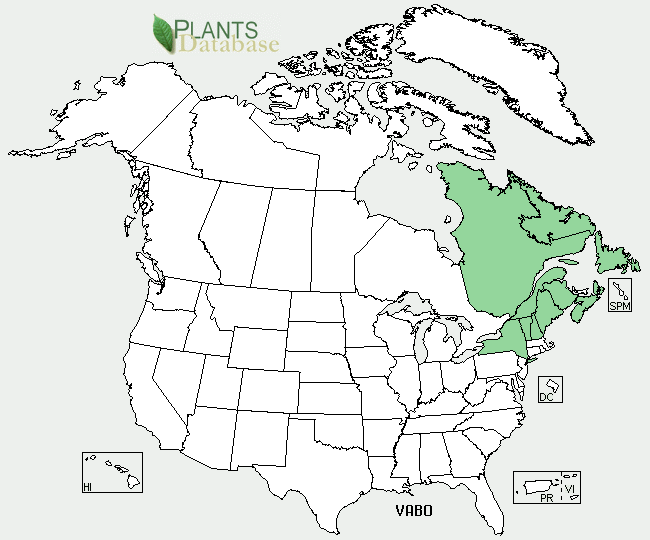
Northern Blueberry (Vaccinium boreale) range. Distribution map courtesy of U. S. Department of Agriculture (USDA Natural Resources Service) and used in accordance with their policies.
New Jersey Blueberry (Vaccinium caesariense).
- USDA Plant Hardiness Zone: no data (More information on hardiness zones).
- Soil pH: no data, but acidic soils
- Plant Size: Up to 1.5 meters (5 feet) high
- Duration: Shrub that can live and produce berries for years
- Leaf Shape: Elliptic to Ovate
- Leaf Phyllotaxis (Arrangement) on branch: Alternate
- Leaf Size: 30–50 mm (1 1/5 to 2 inches) long, 15–20 mm (3/5 to 4/5 inch) wide
- Leaf Margin: very, very finely Serrated (saw toothed edge), appearing as Entire (smooth edged) without a careful, up close look
- Leaf Notes: Sometimes the leaves are light green that blush red near the margins - the closer to the margin, the more red. Sometimes they will be green with light blotching of red.
- Flowers: White, to a clear or translucent white
- Fruit: The Blueberry is about 8 mm (1/3 inch) in diameter.
- Bark: twigs have a reddish hue usually, but can be green to almost yellowish.
- Habitat: Moist, but well drained acidic soil - does not tolerate lime in soil or limestone. Likes peat in soil. Prefers full sun, but can tolerate partial shade, but with less fruiting.
Web Resources:
- Pictures on the web here (Google images) and here (Bing images).
- Interactive USDA distribution map and plant profile here.
- The Biota of North America Program (BONAP) distribution map here. BONAP map color key here.
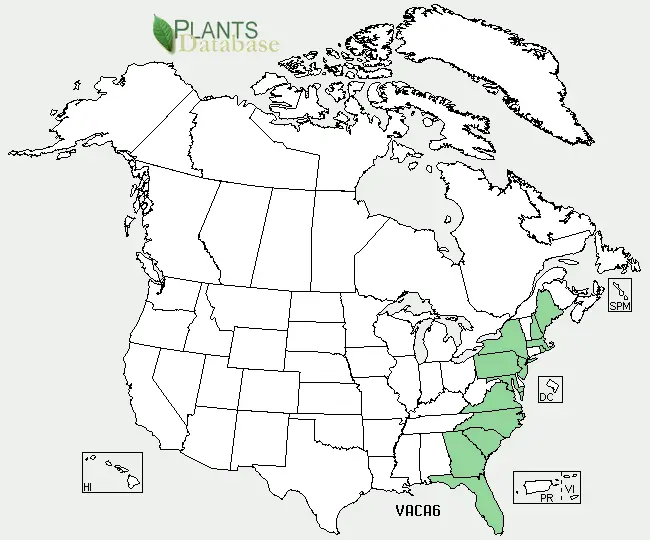
New Jersey Blueberry (Vaccinium caesariense) range. Distribution map courtesy of U. S. Department of Agriculture (USDA Natural Resources Service) and used in accordance with their policies.
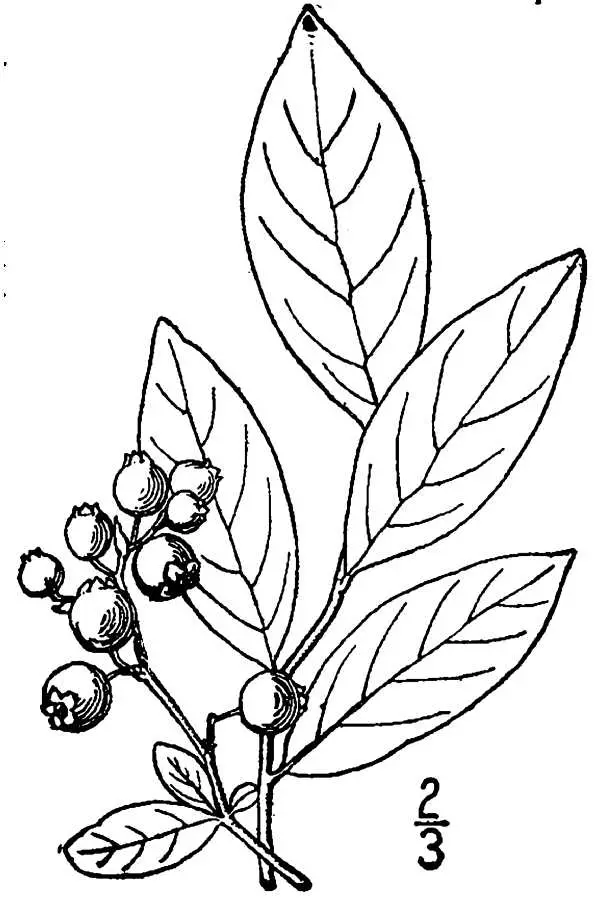
New Jersey Blueberry drawing. (USDA-NRCS PLANTS Database / Britton, N.L., and A. Brown. 1913. An illustrated flora of the northern United States, Canada and the British Possessions. 3 vols. Charles Scribner's Sons, New York. Vol. 2: 701.)
Southern Highbush Blueberry (Vaccinium darrowii). Other names include: Scrub Blueberry, Highbush Blueberry, Darrow's Blueberry.
- USDA Plant Hardiness Zone: 8-10 (More information on hardiness zones).
- Soil pH: 4.0-5.5
- Plant Size: 30–120 cm (1 to 4 feet) tall
- Duration: Shrub that can live and produce fruit for years
- Leaf Shape: Ovate to Elliptic
- Leaf Phyllotaxis (Arrangement) on branch: Alternate
- Leaf Size: 10–15 mm (2/5 to 3/5 inch) long
- Leaf Margin: Entire (smooth edged)
- Leaf Notes: Different cultivars have different leaf colors. Some hybrids have dark green leaves, but wild ones tend to have light green leaves with the very upper ones having a reddish or pink tint.
- Flowers: Flowers in March to April. White to light pink. 4-8 mm long
- Fruit: Blue-black color. 4-6 mm diameter.
- Bark: Branches are reddish, except for the new growth which is green
- Habitat: Open Pine forests in Southeastern USA. Slightly acidic soils. Partial shade to full sun. Prefers sandy soils. Moist to dry soils.
Web Resources:
- Pictures on the web here. (Google images) and here (Bing images).
- Interactive USDA distribution map and plant profile here.
- The Biota of North America Program (BONAP) distribution map here. BONAP map color key here.
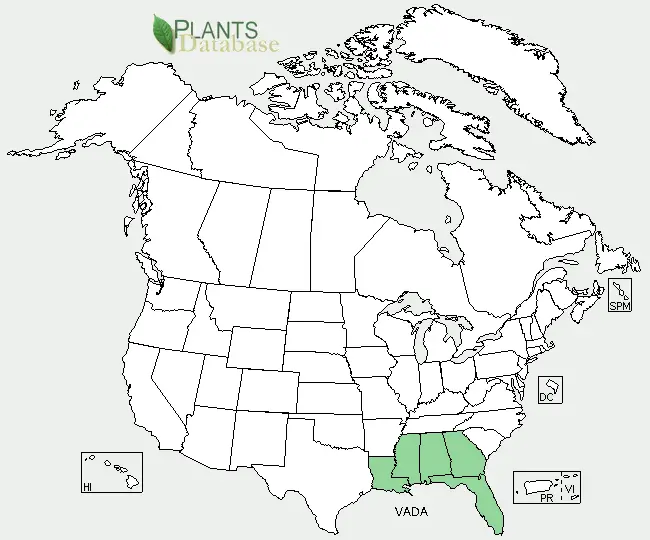
Southern Highbush Blueberry (Vaccinium darrowii) range. Distribution map courtesy of U. S. Department of Agriculture (USDA Natural Resources Service) and used in accordance with their policies.
Elliott's Blueberry (Vaccinium elliottii). This variety is known to have more sour tasting fruit that other Blueberry species, but still quite edible, and very good for cooking with. Each shrub can produce a large crop of fruit.
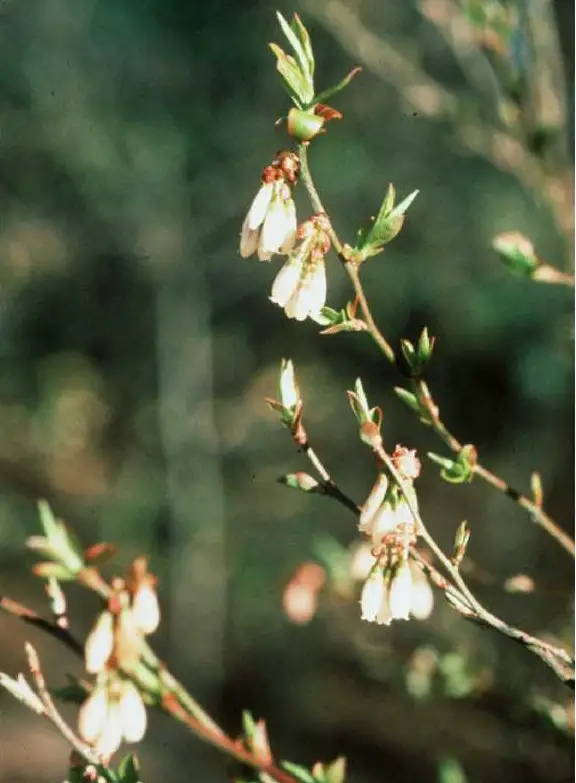
Elliott's Blueberry bush. (Robert H. Mohlenbrock, hosted by the USDA-NRCS PLANTS Database / USDA SCS. 1991. Southern wetland flora: Field office guide to plant species. South National Technical Center, Fort Worth.)
- USDA Plant Hardiness Zone: 6-9 (More information on hardiness zones).
- Soil pH: 4.5-5.5
- Plant Size: 2-4 meters (6 to 13 feet) tall
- Duration: Shrub that can live and produce fruit for many years
- Leaf Shape: Ovate to Elliptic
- Leaf Phyllotaxis (Arrangement) on branch: Alternate
- Leaf Size: 15-30 mm (3/5 to 1 1/5 inches) long
- Leaf Margin: Very finely Serrated (saw toothed edge)
- Flowers: Light pink, lantern or bell-shaped, 6-8 mm long
- Fruit: 5-8 mm diameter, two variants: shiny blue-black (tart tasting), the other blue-black with white bloom (sweeter taste)
- Bark: New growth green, older branches green and reddish brown.
- Habitat: Dry sandy upland forest areas to flood prone areas. Likes acidic to very acidic soils. Full sun to part shade.
Web Resources:
- Pictures on the web here (Google images) and here (Bing images).
- Interactive USDA distribution map and plant profile here.
- The Biota of North America Program (BONAP) distribution map here. BONAP map color key here.
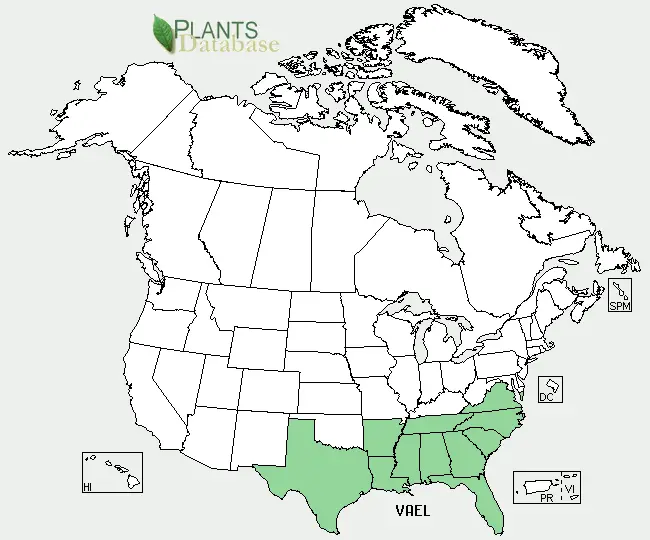
Elliott's Blueberry (Vaccinium elliottii) range. Distribution map courtesy of U. S. Department of Agriculture (USDA Natural Resources Service) and used in accordance with their policies.
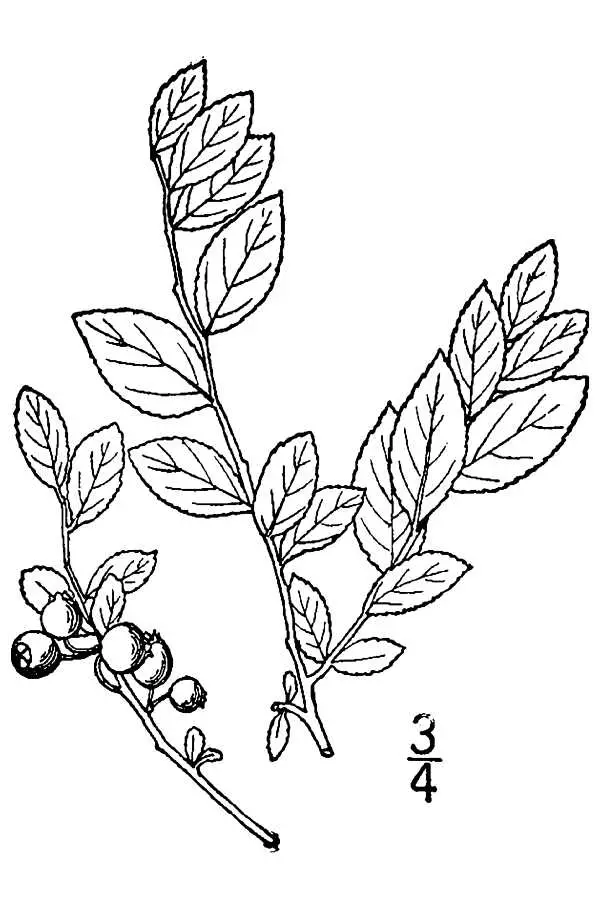
Elliott's Blueberry drawing. (USDA-NRCS PLANTS Database / Britton, N.L., and A. Brown. 1913. An illustrated flora of the northern United States, Canada and the British Possessions. 3 vols. Charles Scribner's Sons, New York. Vol. 2: 703.)
Hillside Blueberry (Vaccinium pallidum). Known also as the Blue Ridge blueberry.
- USDA Plant Hardiness Zone: 3-9 (More information on hardiness zones).
- Soil pH: no data, but acidic soils
- Plant Size: Highly variable in height. Can be from 10 to 100 cm, (4 to 40 inches) but usually in the lower to middle of that range. This plant can form clonal colonies, that is, an area of this plant that all sprouted from the roots of one parent shrub, so that all are basically the same plant or clones.
- Duration: Shrub that can live and produce fruit for many years.
- Leaf Shape: Ovate
- Leaf Phyllotaxis (Arrangement) on branch: Alternate
- Leaf Size: 2-6 cm (4/5 to 2 1/3 inches) long
- Leaf Margin: Entire (smooth edged) or very finely Serrated (saw toothed edge) near the tip of the leaf
- Leaf Notes: In summer: green to yellowish green or bluish green, red in fall
- Flowers: Lantern or Bell shaped, white, light pink or light green, racemes of up to 11 flowers. 5-10 mm long
- Fruit: 12 mm diameter, blue to blackish in color, rarely white (use extreme caution if you think you have found a white Blueberry - there are very dangerous white berries in racemes - for example: Poison Ivy, Western Poison Ivy, Poison Sumac, White Baneberry or Doll's-eyes - don't even touch them unless you are 100% sure they are white Blueberries)
- Bark: Red to greenish brown on stems, new growth can be grey, green, reddish or yellowish.
- Habitat: Highly variable - associated with both hardwoods like Oak and Maple, as well as conifers. Dry areas mainly, but can be found near to wetlands with Silver Maple. Likes humid areas. Sandy, clay or rocky soils. Prefers acidic soil with partial shade/sun.
Web Resources:
- Pictures on the web here (Google images) and here (Bing images).
- Interactive USDA distribution map and plant profile here.
- The Biota of North America Program (BONAP) distribution map here. BONAP map color key here.
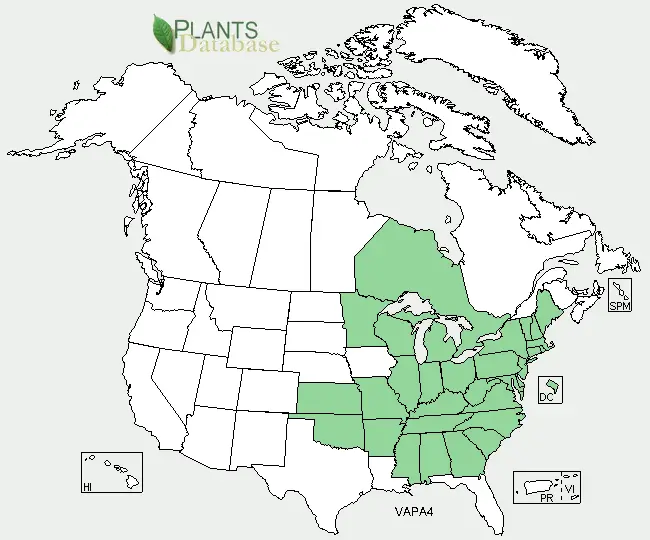
Hillside Blueberry (Vaccinium pallidum) range. Distribution map courtesy of U. S. Department of Agriculture (USDA Natural Resources Service) and used in accordance with their policies.
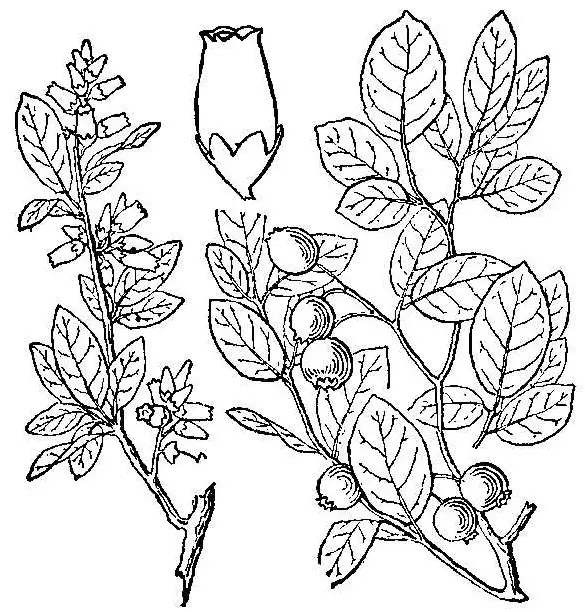
Hillside Blueberry drawing. (USDA-NRCS PLANTS Database / Britton, N.L., and A. Brown. 1913. An illustrated flora of the northern United States, Canada and the British Possessions. 3 vols. Charles Scribner's Sons, New York. Vol. 2: 702.)
Rabbit-eye Blueberry or Southern Black Blueberry (Vaccinium virgatum). Known also as the Smallflower blueberry.
- USDA Plant Hardiness Zone: 7-10 (More information on hardiness zones).
- Soil pH: 4.0-5.5 (best around 4.0-4.5)
- Plant Size: 1-2 meters (3 to 6 feet) tall
- Duration: Shrub that can live and produce fruit for many years
- Leaf Shape: Elliptic
- Leaf Phyllotaxis (Arrangement) on branch: Alternate
- Leaf Size: To 7.5 cm (3 inches) long
- Leaf Margin: Entire (smooth edged), although under magnification you can see it is very, very finely Serrated (saw toothed edge)
- Leaf Notes: In spring the leaves can be reddish-gold, then turning dark green as the season matures
- Flowers: The lantern, or bell shaped flowers are white and about 5 mm long
- Fruit: Dark blue to black, about 5 mm diameter, with waxy bloom
- Habitat: Southeastern USA, wide range of acidic soil conditions from dry to wet land, sun to part shade
Web Resources:
- Pictures on the web here (Google images) and here (Bing images).
- Interactive USDA distribution map and plant profile here.

Rabbit-eye Blueberry or Southern Black Blueberry (Vaccinium virgatum) range. Distribution map courtesy of U. S. Department of Agriculture (USDA Natural Resources Service) and used in accordance with their policies.
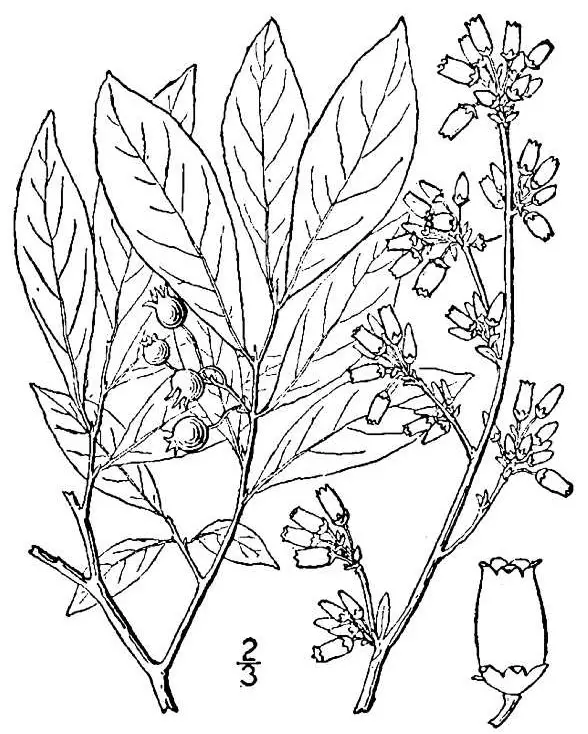
Rabbit-eye Blueberry or Southern Black Blueberry drawing. (USDA-NRCS PLANTS Database / Britton, N.L., and A. Brown. 1913. An illustrated flora of the northern United States, Canada and the British Possessions. 3 vols. Charles Scribner's Sons, New York. Vol. 2: 703.)
There are others in this family, the list I provide is not complete. Here are places to start for further information:
- Vaccinium genus.
- The Biota of North America Program (BONAP) distribution map here. BONAP map color key here.
Search Wild Foods Home Garden & Nature's Restaurant Websites:
Share:
Why does this site have ads?
Originally the content in this site was a book that was sold through Amazon worldwide. However, I wanted the information to available to everyone free of charge, so I made this website. The ads on the site help cover the cost of maintaining the site and keeping it available.
Google + profile
